Tennis Elbow
Tennis elbow is a chronic inflammation of a tendon of the outside of the elbow. It is also known as 'lateral epicondylitis' .
Cause:
The exact cause of tennis elbow is not known, but it does tend to occur after repetitive use of the extensor tendons at the elbow, originating from the Extensor Carpi Radialis (ECRB) tendon , such as in tennis (hence the name). These tendons are involved in extending the wrist joint and is also active when gripping with the wrist extended (as in tennis). Any activity that twists and extends the wrist can lead to tennis elbow.
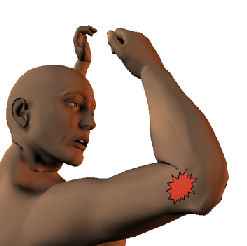
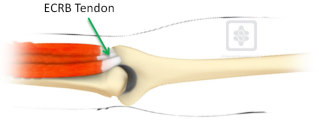
The tendons become chronically irritated and worn. This leads to the pain with activities.
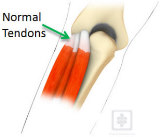
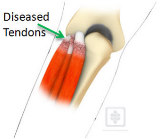
Presentation:
The first sign of tennis elbow is usually tenderness and pain when pressure is applied to the outside of the elbow. If left untreated, a dull constant pain or sharp shooting pain can be felt. Swelling may be present. Other symptoms include:
- Pain when the wrist or hand is straightened (wrist extension)
- Pain felt when lifting a heavy object
- Pain when making a fist or shaking hands
- Shooting pains from the elbow down to the forearm or up into the upper arm
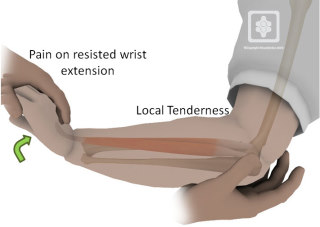
Pain with tennis elbow is typically localised over the bony bump on the outside of the elbow (lateral epicondyle) and may extend down to the hand. This area is usually very tender to touch. Rest usually relieves the pain.
Sometimes other conditions that are not linked to tennis elbow can cause pain in the elbow. For example, arthritis of the elbow, a pinched nerve in the neck, shoulder impingement and carpal tunnel syndrome.
Treatment:
The type and duration of the treatment will depend on the severity of the condition. The first step in treating tennis elbow is to manage the activities that cause the pain, such as tennis or golf.
- Pain killers and anti-inflammatory medications relieve the pain and reduce the inflammation.
- A tennis elbow strap can be worn just below the elbow to limit the stress on the ECRB tendon.
- Treating the area with an ice pack and performing an ice massage are also recommended.
- Physiotherapy to release the tendon inflammation and retrain the extensor muscles is important. Eccentric exercise programmes are popular and prove effective in 70% of cases.
Injections: If the condition does not respond to the above treatments, injections are often used. Steroid injections are the most commonly used injections, but they generally wear off after a few months and may need repeating. More recently Platelet Rich Plasma (PRP) injections have shown to be more effective than steroid injections, but are much more expensive.
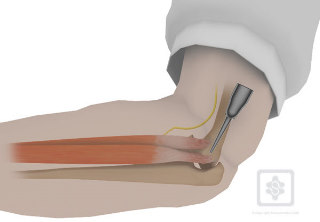
Surgery: For very severe cases and those that fail to improve after injections surgery may be necessary. The surgery is usually performed as day case surgery. This may be performed by an open approach, percutaneous or arthroscopically (keyhole) . There are pros and cons to each of these methods, but the results are similar.
You will be able to start moving your elbow normally two days after the surgery, with 1 week off work. Full recovery may take three months.
Prevention:
To prevent tennis elbow from reoccurring, it is important to make sure you keep the muscles strong by exercise and using the proper form whether playing tennis or lifting heavy objects. Warming up before starting to use the muscle will also help prevent the condition. After exercising, you may want to ice and stretch the elbow and arm muscles.
Also See:
- Latest News & Research on the Elbow
- Eccentric exercise programme
- PRP for Tennis elbow - randomized controlled trial


